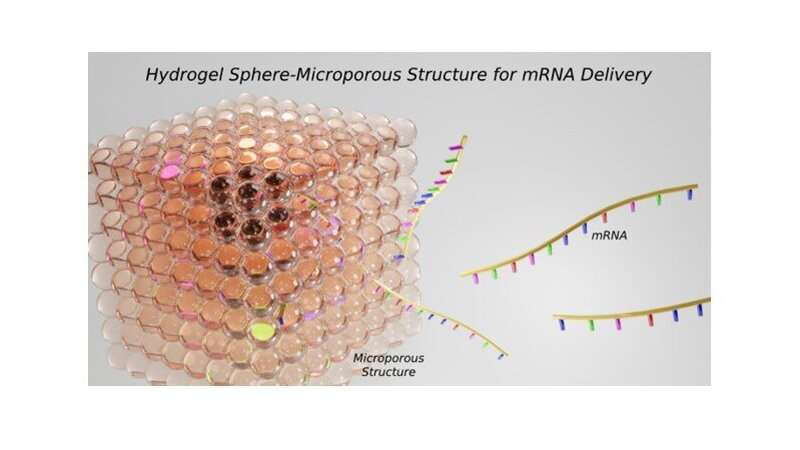This article has been reviewed according to Science X's editorial process and policies. Editors have highlighted the following attributes while ensuring the content's credibility:
fact-checked
proofread
Hydrogel spheres compose a microporous structure for localized mRNA delivery

In a significant leap forward in the realm of regenerative medicine, a team at the Terasaki Institute for Biomedical Innovation has introduced a pioneering approach to mRNA therapy using microspheres made of gelatin methacryloyl (GelMA)—a gelatin-based polymer that can form strong hydrogels when exposed to UV light—to form microporous structure.
This novel development marks a critical milestone in addressing the complex challenges associated with targeted mRNA delivery, a pivotal aspect of modern therapeutic strategies.
Messenger RNA (mRNA) therapy, which involves the delivery of mRNA into the cells to induce the production of therapeutic proteins, has been a focal point in medical research, particularly highlighted by its vital role in recent vaccine developments. However, a significant hurdle in this domain has been ensuring the targeted and efficient delivery of mRNA to specific tissues. This is crucial in scenarios where traditional systemic delivery methods are either impractical or lead to unintended side effects.
The innovative microporous structures provide a much-needed solution by facilitating localized delivery directly to the desired tissue sites.
As reported in their paper in Aggegate, the study delves deep into the intricacies of these microporous structures, engineered through an advanced microfluidic process and consisting of microporous annealed microspheres adept at protecting the mRNA from degradation while ensuring its safe and effective delivery into the cells.
Notably, these microporous structures are composed of optimized concentrations of the gelatin-based polymer to create an environment that supports and enhances cell viability, infiltration, adhesion, proliferation, and, importantly, gene transfer.
The key to the effectiveness of these microporous structures lies in their composition and structural design, which enables the sustained release of mRNA, ensuring a continuous and targeted therapeutic impact. This feature is particularly pivotal in regenerative medicine and tissue engineering applications, where precision and efficiency in delivery systems are paramount.
This research stands as a beacon of innovation in the field of biomedical research, offering new hope and possibilities for patients requiring targeted mRNA therapy. The development of the mRNA-releasing microporous structures is a testament to the relentless pursuit of cutting-edge solutions that hold the potential to revolutionize patient care. It signifies a step forward in treating conditions that necessitate precise and efficient delivery of therapeutic agents, paving the way for improved patient outcomes and quality of life.
Looking ahead, the implications of this groundbreaking research extend well beyond the immediate realm of mRNA delivery. The foundational principles and techniques employed in the development of these microporous structures could potentially influence a wide range of applications in tissue engineering and regenerative medicine. The possibilities are vast, ranging from targeted drug delivery to the regeneration of complex tissues, opening new horizons in medical science.
More information: Bruna Gregatti Carvalho et al, Gelatin methacryloyl granular scaffolds for localized mRNA delivery, Aggregate (2023). DOI: 10.1002/agt2.464
Provided by Terasaki Institute for Biomedical Innovation



















